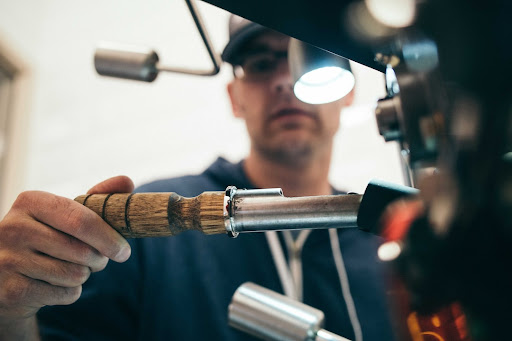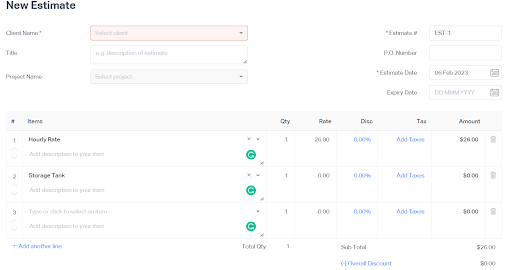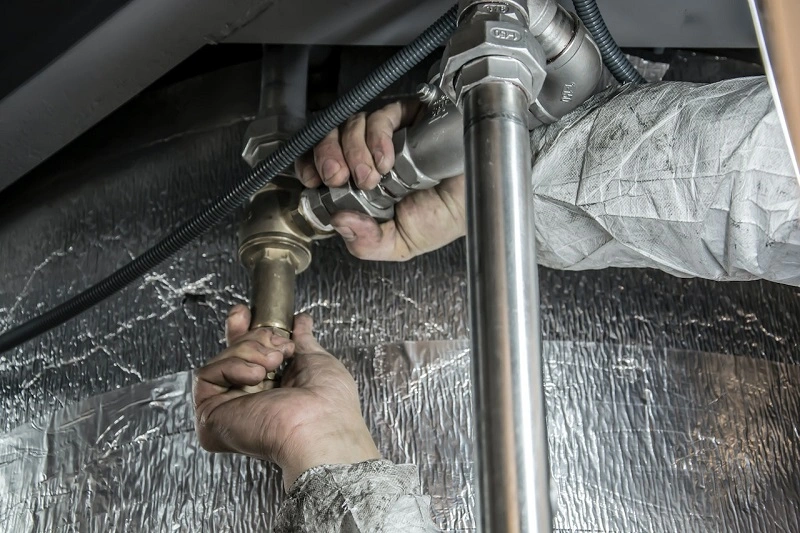Plumbing jobs can range from simple repairs to complex installations, and estimating the cost of a plumbing project can be a challenging task for many contractors.
Whether you are a plumbing contractor bidding for a residential project or a commercial one, it is vital to have a clear understanding of the job scope, materials required, and the time frame for completing the project.
Keep reading for a step-by-step guide on how to estimate a plumbing job accurately and competitively.

Factors to Consider Before Estimating a Plumbing Job
Before you start estimating the cost of a plumbing job, you should consider several factors.
Type of Project
The type of plumbing project will determine the scope of work and materials needed. For example, a simple repair job may require fewer materials than an installation job. It is crucial to have a clear understanding of what needs to be done before estimating the cost of the project.
- For a residential plumbing job, you will need to consider the size of the house and how many bathrooms it has. It is also important to note that some materials used for residential plumbing jobs are not suitable for commercial ones.
- For 3/4 bedroom residential projects, you will likely need to install the necessary fixtures, such as toilets, bathtubs, showers, and sinks.
- For commercial plumbing jobs, consider factors such as the size of the business and how many bathrooms it has. Additionally, some materials used for residential plumbing jobs may not be suitable for commercial ones due to their complexity.
- For a shop or office space project, you will typically need to install pipes and drains in addition to the usual fixtures mentioned above.
You also need to list what services you are offering (e.g., installation, repair, maintenance) and the materials required for each service (which will be discussed later).
Here’s a sample average figure of prices for plumbing services in the USA, according to HomeGuide.com:
- Plumbers typically charge hourly rates between $50 and $150 per hour
- Minimum fee for standard services is usually between $50 and $100
- Installing a kitchen faucet may cost from $125 to $350
- Relocating existing plumbing projects can cost anywhere from $500 to $800
This includes labor costs and materials, depending on the project size and complexity.
Base Rate
Another factor to consider is the base rate for the job. This includes any labor costs that are not related to materials, such as travel expenses and any additional fees associated with the project. It is essential to know what your base rate for a plumbing project is, so you can accurately calculate how much it will cost to complete the job.
Determining your base rate is simple: get your hourly rate and billable hours. Your hourly rate is the cost per hour for your services, while the billable hours are the total amount of time you will need to complete the job.
So you want to earn around $750 per week, and you expect to work 40 hours a week. Your base rate would be $18.75 per hour ($750/40).
Take note that it’s highly advisable to research your area’s prevailing rates before setting your own rate, as you want to ensure that you are competitive in the market.
Materials
Let’s get into the nitty gritty of estimating a plumbing job. You will need to factor in the cost of materials when calculating your estimates. But then again, materials will be based on the type of project or service you are providing. Here are some examples of services and the materials you will need to consider:
1. Burst Pipe Repair
- Labor Cost: $100 to $200 per foot
- Pipe: PVC pipe, copper pipe, galvanized pipes ($25 – $150)
- Fittings: Couplings, unions, elbow fittings ($5 – $20)
- Tools and Equipment: Pipe wrenches, hacksaw ($10 – $30)
2. Drain Cleaning
- Labor Cost: $100 to $275
- Supplies & Tools: Snake/auger, drain cleaning chemicals ($50 – $200)
- Equipment Rental (if applicable): Auger rental costs can vary depending on the size and type of auger used. Expect to pay around $75 per day for a medium size electric auger.
3. Repiping
- Labor Cost: $3,900 and $7,500
- Pipe: Copper pipe ($50 – $100 per linear foot)
- Fittings: Couplings, unions, elbow fittings ($5 – $20)
- Tools and Equipment: Pipe wrenches, hacksaw ($10 – $30)
4. Water Heater Installation
- Labor Cost: $150 to $700
- Water Heater: Standard water heater ($300 -$600)
- Tools and Equipment: Pipe wrenches, hacksaw ($10 – $30)
All these estimates were based on HomeGuide and HomeDepot’s current pricing. It is important to research the current market prices for these materials before estimating any costs.
Doing so will also help you avoid overcharging your clients or bidding too low on projects.
Overhead Expenses and Total Labor Cost
Overhead costs are expenses that are not directly related to the project but are still necessary. These include administrative fees, insurance costs, and any taxes associated with the job. Calculating overhead costs is very simple, just add up all the expenses and divide it by your billable hours.
In order to accurately estimate plumbing costs, all construction professionals must incorporate their overhead and profit into the total. To do this, it is essential to know the exact dollar amount of all of your operating expenses. These expenses can include:
Office expenses, including your rent or lease: $4,500 – $7,000
- Insurance: $125 – $1,400
- Professional fees: $400 – $600
- Advertising and marketing expenses: $400 -$800
- Vehicle expenses (gas, maintenance): $700 -$1,100
- Miscellaneous costs (supplies, uniforms): $200-$300
These figures are just an estimate, and you should adjust them according to your own business’s needs.
Next, you will need to factor in the total labor cost for the project. This includes both direct labor costs, such as wages for workers, and indirect labor costs, such as any overtime pay or benefits associated with the job. To calculate this cost accurately, multiply your base rate by the number of hours you expect to spend working on the plumbing project.
Here’s how you can calculate your total labor cost:
Total Labor Cost = (Hourly Rate x Hours Worked) + Overhead Costs
For example, if you charge $50 per hour for plumbing services and expect to spend 25 hours working on a project, your total labor cost would be ($50 x 25) + Overhead Costs.
Estimating the hours accurately will not only help you make sure that you are making a profit from the job but also ensure that your customer is getting the best value for their money.
Margins and Markup
Once you have determined the base rate, overhead expenses, and total labor costs, it is time to factor in margins and markup.
Margin is the amount of profit that you make on each job. Markup refers to the percentage added on top of your cost to cover overhead expenses and generate a profit. Generally, contractors should aim for a margin of 20-30% and a markup between 10-20%.
The reason behind this number is that it allows you to cover all your costs, generate a profit and remain competitive in the market. A sample computation to determine your markup would look like this:
Let’s say the cost of materials for a Burst Pipe Repair is $250. Your total labor cost for the job is $400 and your overhead expenses are $1,000.
Total Cost = Materials + Labor + Overhead
- Total Cost = $250 + $400 + $1,000
- Total Cost = $1,650
- Margin: 20%
- Markup: 10%
Final Price Computation = Total Cost x (1+ Margin) x (1+ Markup) =$1,650 x 1.2 x 1.1
Final Estimate Price = $2,170
Create A Quotation Via Billbooks.com
What to do next? Add them up, and you have the total estimated cost of the plumbing job.
But it’s not as simple as that.
You must explain the breakdown to send the total estimated cost to your client. Make sure you provide an itemized list of all the costs, including materials, labor, and overhead expenses.
This will help your clients understand why they are being charged a certain amount for the job. Billbooks is an online software that can help you quickly create professional quotes and invoices, helping you close more jobs in less time.
Here’s a sample screenshot of a blank quotation created with Billbooks.com:

As you can see, you can easily add the details of your plumbing job in this template. This includes the type of project, base rate, materials required, labor cost, and markup percentage. It allows you to itemize each cost and add notes or descriptions on the side so your clients understand exactly what they are being charged for.
Once all the information is filled up correctly, you will be able to generate an accurate quotation for your plumbing job.
It also provides features such as customizable templates, automated payment reminders, multiple currency support, and more. With these tools, you can streamline the process of creating quotations for your plumbing jobs and close more projects in less time.
Bottom Line
Estimating a plumbing job correctly is essential for success as a contractor. By following the guidelines outlined above, you will be able to accurately calculate the cost of each project, ensuring that you remain competitive while still making a profit.
With the help of online invoicing and billing software such as Billbooks.com, the process of creating quotations for your plumbing jobs becomes more accessible and faster.



